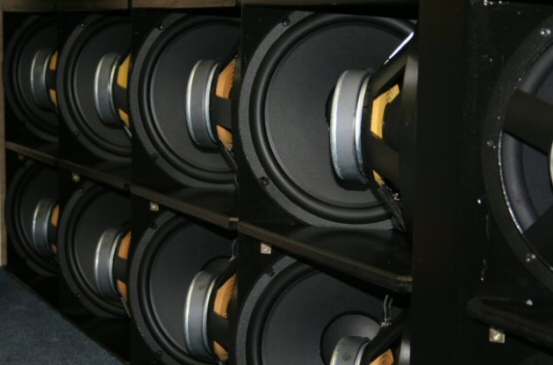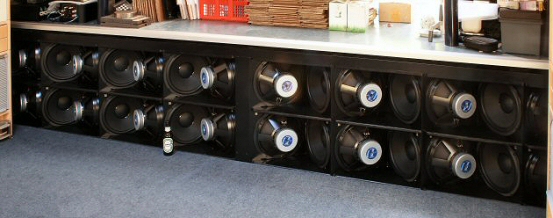Ultimate Subwoofer
The Ultimate Subwoofer is going down to real deep sub frequencies without any noticeable distortions.
Most subwoofers are designed using a woofer with high excursion capabilities though and the need for a very powerful amplifier. Even mechanical woofers capable of extreme excursion are designed for producing sub frequencies instead of creating a large diaphragm for optimal coupling to the surrounding air to produce clean bass....
This is similar to the most stupid commercial period of using high powered amplifiers and very low sensitive loudspeakers claiming to be an improvement over high sensitive loudspeakers... we know better and thankfully, more and more commercial loudspeaker designers start to think the same.
Most "newly" designed loudspeakers all have a good efficiency (average over 92 dB for one Watt) but why not thinking the same while designing subwoofers ...?
From a commercial point of view it is understandable to design relative small systems trying to fool nature by using low sensitive high excursion woofers with a rather heavy diaphragm driven by a very strong amplifier. This is most easy but not the best possible way for clean, low distortion and powerful (sub)bass!

A good performing subwoofer should be big because producing real low frequencies without much distortion can only be reproduced by a very large diaphragm and not just by moving air using woofers high excursion, as many people still tend to believe.
Why do I need a subwoofer in the first place?
You do not need a subwoofer for normal music playback, there are not many instruments that go below 35 Hz. If a certain loudspeaker system is doing a good job down to 35 Hz then it is hard to imagine the need for deeper frequencies, so why spend money on that? Perhaps for the few recordings where the artists use a synthesizer or a play a big organ where frequencies are used down to 16 Hz (organ) or even lower (synthesizer)?
If you listen to that type of music then it will be very worthwhile to extend your bass range but, as a bonus and new to most people, it is not just about reproducing real instruments! Did you ever thought about ambiance? Sensing the size of the concert hall or the church or even the space catched on recordings made outside?
Most people do not know this (never experienced it...) and therefore do not care about that, at least not enough to spend money to extend their bass range down to real sub frequencies...unless , of course, when they have a Home Theater system where a subwoofer is usually taking a central and crucial position for having all effects created present and audible/sensible. How much fun can a movie with some action be without a good subwoofer....?
What is a good subwoofer anyhow?
- one you can't hear producing sub frequencies - only feeling the vibration
- one you can't localize - free of distortion
- one that is able to play much deeper in frequency than 20 Hz
What is a bad subwoofer?
- one you can hear when trying to produce sub frequencies
- one you can localize and hear where the sound is coming from
- one that is not able to play deeper in frequency than 20 Hz
Which principles used are most responsible for a bad subwoofer?
- using a relative small driver (small moving diaphragm area) and using a relative small enclosure
- using a relative small driver with high excursion to compensate the size
- using a ported enclosure in general
- having internal dimensions larger than 1/8th of the wavelength it will play unless it is an endless tapered enclosure without parallel walls.
What is needed for a good subwoofer?
For a good subwoofer you need more space with a proper sized enclosure and a good quality driver with a high powered amplifier to have some headroom to equalize the frequency response of the system to at least 16 Hz. and when the used driver is capable to withstand the power used (heating up the coil) and which is able to make enormous excursions without mechanical noise, then this would be a good subwoofer for most people.
The bigger the driver (when still acting as a rigid piston), the higher the excursion capabilities and the more powerful the amplifier the deeper in frequency it will be able to go....but would that be the most optimal and how deep in frequency would we need to go anyhow ...?
What is needed for an optimal subwoofer?
- an optimal subwoofer should play down to at least 10 Hz (-3 dB)
- an optimal woofer should not create any distortion whatsoever from itself
- an optimal subwoofer should have an extreme sized moving diaphragm so that is does not move much
- an optimal subwoofer should have a very high sensitivity and use the energy from the amplifier to produce pressure, not heat...
Okay, welcome to my project as this is what I intended to create for many years but never found the time or urge to start with that. People knowing me are aware that I have build several enormous bass systems based on horns in the past.
The major reason why I preferred horns to do this task is described in the Bass Horn article which was the first one I build.
The last one is still here and was used to create the Ultimate Subwoofer as described below.
The Ultimate Subwoofer
Why using a very good bass horn as basis for the Ultimate Subwoofer, what is wrong with that beautiful horn in the first place?

This horn was built for optimal bass and in many ways it is. It was made from bricks and concrete, extremely stiff and therefore without any vibrating walls for clean bass. With a length of 5,35 m (Fc 16 Hz!) it produced clean bass from 150 Hz flat down to 24 Hz but dropped quickly below. Lately I have used a Behringer DCX2496 to EQ this horn down to 15 Hz shaking the listening chair already.....
Okay so far but there are some basic problems with such a horn for using it as bass system and even more as subwoofer. The major problem is its time delay of more than 15 ms...and that is the reason why I never used it for music playback for years, only for Home Cinema giving the subwoofer effects while watching movies.
This time delay is very disturbing as the bass is never coherent with the rest of the system making impulse rich bass (like bass drums) sounding "weak" and without dynamics.... even when used as subwoofer (below 30 Hz) this mis-alignment is disturbing optimal integration.
This delay could be "cured" by delaying the rest of the system with digital devices but that is not what I was after, why killing the quality of the most important spectrum by adding jitter?
Another problem is that such a horn needs the room to build-up the deeper bass and the fact that the real efficiency in the sub range (below 24 Hz) is highly reduced...time to change things.
Thinking about subwoofers in general and implementing their function the most optimal way brewed the idea to cure the time delay and move the bass driver to the front (mouth) of the horn (backward loaded horn). This would work better in the higher bass notes but it would not be as effective as a commonly loaded horn and this would even further reduce the sensitivity in the sub range!
The final idea was to close the horn mouth with as many usable bass drivers as possible which turned out to be the ultimate solution!

The subwoofer as it is today has an extreme stiff enclosure, no parallel walls, no time delay, a huge total moving diaphragm surface working as a stiff piston, extreme high sensitivity down into the sub range, no need for the room to build-up the bass and, as a big bonus... it does not take up more space!
Some technical data of the Ultimate Subwoofer:
- Sensitivity per channel - 112dB/1Watt/1m (in room about 92dB/1Watt/1m @ 10Hz)
- System used frequency response - 10 Hz to 22 Hz (after EQ and crossover)
- Total moving diaphragm area - 17.280 cm2 (1,728 m2)
- System Fc - 44 Hz with Qtc - 0,5
- Total 12" woofers used - 32 x Beyma 12BR70 (16 per channel)
- Total impedance - 8 ohms (4 sets in serial connected drivers wired in parallel)
- Dimensions - 400*300*64cm (W*D*H), Netto total volume - 4.650 liters
- Using a Behringer Ultradrive Pro DCX2496 as crossover and EQ (low pass at 22 Hz with a slope of 48 dB)
- Using the BD-Design CrazyA amplifier to drive this monster (2 x 50 Watt and bass configured)
WARNING: Real sub frequencies on a level that is too high can cause serious injuries to your organs!